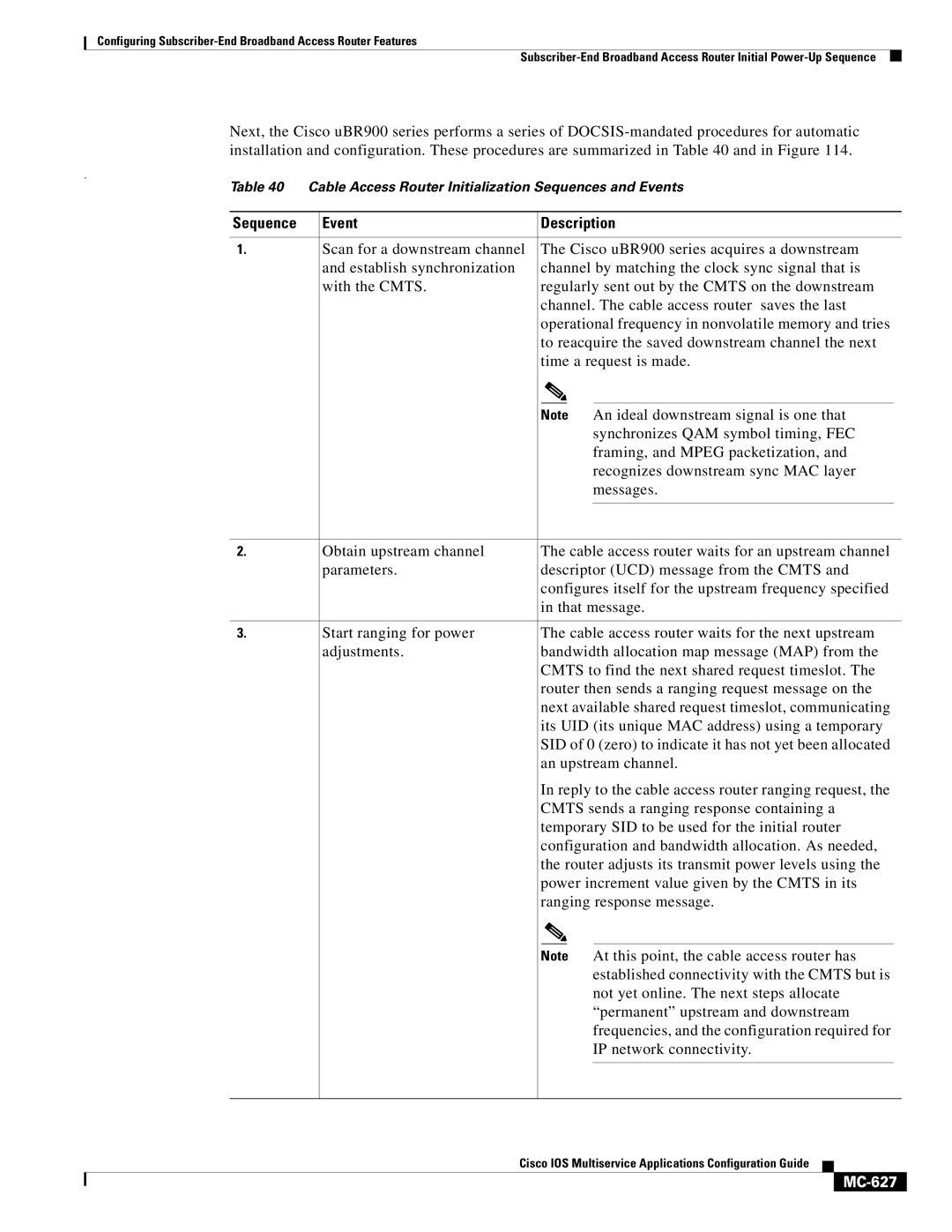
Configuring
Next, the Cisco uBR900 series performs a series of
.
Table 40 | Cable Access Router Initialization Sequences and Events |
| |||||||
|
|
|
|
| |||||
Sequence |
| Event | Description |
| |||||
|
|
|
|
|
| ||||
1. |
| Scan for a downstream channel |
| The Cisco uBR900 series acquires a downstream |
| ||||
|
| and establish synchronization |
| channel by matching the clock sync signal that is |
| ||||
|
| with the CMTS. |
| regularly sent out by the CMTS on the downstream |
| ||||
|
|
|
| channel. The cable access router saves the last |
| ||||
|
|
|
| operational frequency in nonvolatile memory and tries |
| ||||
|
|
|
| to reacquire the saved downstream channel the next |
| ||||
|
|
|
| time a request is made. |
| ||||
|
|
|
|
|
|
|
| ||
|
|
|
| Note | An ideal downstream signal is one that |
| |||
|
|
|
|
|
| synchronizes QAM symbol timing, FEC |
| ||
|
|
|
|
|
| framing, and MPEG packetization, and |
| ||
|
|
|
|
|
| recognizes downstream sync MAC layer |
| ||
|
|
|
|
|
| messages. |
| ||
|
|
|
|
|
|
| |||
|
|
|
|
|
| ||||
2. |
| Obtain upstream channel |
| The cable access router waits for an upstream channel |
| ||||
|
| parameters. |
| descriptor (UCD) message from the CMTS and |
| ||||
|
|
|
| configures itself for the upstream frequency specified |
| ||||
|
|
|
| in that message. |
| ||||
|
|
|
|
|
| ||||
3. |
| Start ranging for power |
| The cable access router waits for the next upstream |
| ||||
|
| adjustments. |
| bandwidth allocation map message (MAP) from the |
| ||||
|
|
|
| CMTS to find the next shared request timeslot. The |
| ||||
|
|
|
| router then sends a ranging request message on the |
| ||||
|
|
|
| next available shared request timeslot, communicating |
| ||||
|
|
|
| its UID (its unique MAC address) using a temporary |
| ||||
|
|
|
| SID of 0 (zero) to indicate it has not yet been allocated |
| ||||
|
|
|
| an upstream channel. |
| ||||
|
|
|
| In reply to the cable access router ranging request, the |
| ||||
|
|
|
| CMTS sends a ranging response containing a |
| ||||
|
|
|
| temporary SID to be used for the initial router |
| ||||
|
|
|
| configuration and bandwidth allocation. As needed, |
| ||||
|
|
|
| the router adjusts its transmit power levels using the |
| ||||
|
|
|
| power increment value given by the CMTS in its |
| ||||
|
|
|
| ranging response message. |
| ||||
|
|
|
|
|
|
|
| ||
|
|
|
| Note | At this point, the cable access router has |
| |||
|
|
|
|
|
| established connectivity with the CMTS but is |
| ||
|
|
|
|
|
| not yet online. The next steps allocate |
| ||
|
|
|
|
|
| “permanent” upstream and downstream |
| ||
|
|
|
|
|
| frequencies, and the configuration required for |
| ||
|
|
|
|
|
| IP network connectivity. |
| ||
|
|
|
|
|
|
|
| ||
|
|
|
|
|
|
| |||
|
| Cisco IOS Multiservice Applications Configuration Guide |
|
|
| ||||
|
|
| |||||||
|
|
|
|
|
|
|
|
|
|
